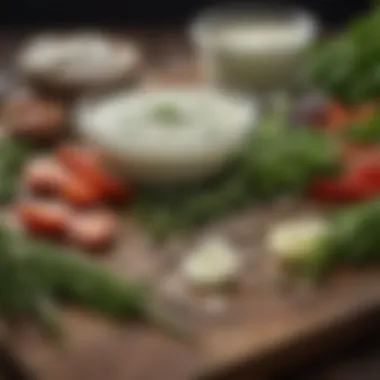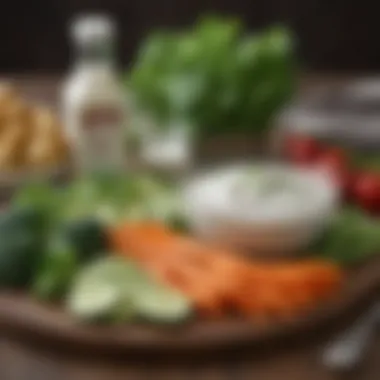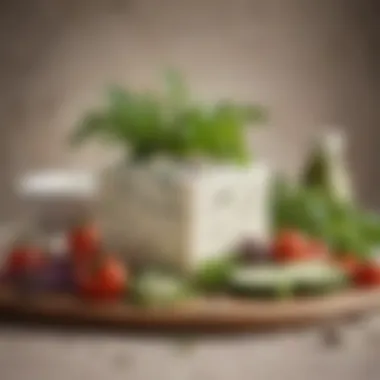Crafting Homemade Ranch Dressing: A Flavorful Journey


Intro
Ranch dressing has become a staple in many households, often seen as a go-to accompaniment for salads, veggies, and even as a dip for those crispy snacks. How did this creamy, zesty concoction come to sit on so many kitchen tables? The roots of ranch dressing run deeper than one might think. Created in the 1950s by a man named Steve Henson on a dude ranch in California, this simple blend of buttermilk, spices, and mayonnaise has evolved into a cultural phenomenon.
Whether you’re pouring it over a fresh salad, slathering it on a sandwich, or using it as a dip for chicken wings, the beauty of making your own ranch dressing lies in its versatility. While many store-bought versions are available, crafting your own allows you to control the flavors, textures, and even health aspects of this beloved condiment.
In this exploration of ranch dressing, we will break down the essentials of creating it from scratch. From understanding the ingredients that make it truly sing to variations that can elevate the classic taste, this guide is tailored for food lovers eager to dabble in homemade culinary delights.
Recipe Overview
Recipe Name
Homemade Ranch Dressing
Cuisine Type
American
Ingredients
List of Ingredients with Measurements
- 1 cup buttermilk
- 1/2 cup mayonnaise
- 1/4 cup sour cream
- 1 tablespoon fresh chives, chopped
- 1 tablespoon fresh parsley, chopped
- 1 teaspoon garlic powder
- 1 teaspoon onion powder
- 1/2 teaspoon dried dill
- Salt and pepper to taste
Substitutions for Common Ingredients
- If you don’t have buttermilk, a mixture of 1 cup of milk mixed with 1 tablespoon of vinegar or lemon juice can work well.
- Greek yogurt can be a healthier alternative to sour cream, giving a nice tang while reducing calories.
- Fresh herbs can be swapped for dried versions; just be aware that dried herbs are generally stronger, so use them sparingly.
Prelims to Ranch Dressing
Ranch dressing has become a staple condiment in countless kitchens across America. But beyond its creamy texture and rich flavor, there's a story woven into its existence. Crafting your own ranch dressing opens up a world of possibilities, from the ingredients you select to the healthy twists you can introduce. This section aims to lay the groundwork, highlighting the significance of making ranch dressing from scratch and its impact on flavor, health, and creativity.
Historical Background
California origins
The birth of ranch dressing can be traced back to the golden state of California, where a man named Steve Henson first concocted this delightful mixture in the 1950s. Starting as a simple buttermilk and herb blend at his ranch, Henson inadvertently tapped into a flavor trend that would sweep the nation. This early origin story is crucial; it enhances our understanding of ranch dressing's approachable yet sophisticated nature. Ranch is imbued with simplicity, which makes it an ideal base for experimentation. It is this versatility that makes ranch dressing such a beloved choice in home kitchens.
Evolution through the decades
As the decades rolled by, ranch dressing went from being a regional specialty to a nationwide sensation. With the 1980s came a surge of creative adaptations. Companies began to bottle ranch dressing, fueling a widespread appreciation. This remarkable evolution highlights ranch dressing’s ability to blend seamlessly into a variety of cuisines. By witnessing its journey, we see how generations have embraced this dressing in diverse ways; think of it as a culinary chameleon. The use of ranch dressing in various dishes reflects its diverse character and the growing inclination towards flavor profiles that are familiar yet exciting.
Popularity in American cuisine
Ranch dressing holds a unique place in American food culture. It doesn’t merely sit as a sidekick to salads; it has carved its niche in everything from veggie platters to chicken wings. Its popularity underscores an important fact: ranch dressing has transcended mere decoration on food, evolving into a necessary component of flavor profiles. This versatility emphasizes its cultural relevance, making it a favored choice for both everyday meals and special occasions. Ranch dressing embodies a deep-seated love for comfort food, cultivated through the simple yet delightful elements it introduces to the table.
Cultural Significance
Ranch dressing in American households
In millions of American households, ranch dressing is more than just another condiment—it's a unifying force. Often, you'll find it at family gatherings, birthday parties, and casual dinners. Its prevalence speaks volumes about its comforting nature. This dressing is not just about taste; it resonates with shared experiences, enhancing the idea of togetherness that food brings. Its simplicity means it can transform the ordinary into something memorable, showcasing its everyday appeal.
Pairing with regional dishes
The beauty of ranch dressing lies in its adaptability. In Texas, spicy ranch dressing might accompany BBQ or nachos, while in the Midwest, it often finds its way onto salads. Such regional pairings reveal how ranch dressing can enhance local flavors, facilitating a deeper connection to culture. The dynamic nature of ranch dressing makes it a fascinating lens through which to view regional culinary identities.
Ranch dressing in restaurants
Ranch dressing has deeply ingrained itself in the restaurant world. From upscale dining to diners, many establishments feature their unique takes on the classic. This widespread inclusion underscores the dressing’s broad appeal and culinary significance. In many ways, it's emblematic of the rise of casual dining, where comfort food meets a gourmet twist. This reflects not only innovation but also a desire to connect back to the essence of home-cooked meals. Rockies’ restaurants might present all kinds of ranch-infused dishes, evolving the dining experience beyond traditional interpretations, putting ranch dressing firmly in the spotlight.
Understanding the Ingredients
Understanding the ingredients that go into ranch dressing is crucial for achieving a harmonious balance of flavors and textures. Each component plays a role, contributing not only to taste but also to the final consistency of the dressing. Educating yourself about these ingredients can elevate your homemade ranch from basic to exceptional, ensuring it satisfies a variety of palates. This section will explore the essential elements that comprise ranch dressing, with a focus on herbs, dairy, and additional flavor enhancers.
Herbs and Spices
Common herbs used


Herbs are the beating heart of ranch dressing. Common choices like parsley, dill, and chives add freshness and complexity. Parsley, for example, lends a grassy note, which is often likened to the taste of a sunny garden day. Dill brings a bit of a sharpness, while chives offer a mild onion flavor. Using a combination can create a multi-layered flavor profile that not only delights the taste buds but also makes each bite unique. These herbs are popular for their versatility and their ability to brighten up the dressing without overwhelming it.
Role of seasonings
Seasonings such as garlic powder, onion powder, and black pepper are essential for building depth in ranch dressing. Garlic powder can bring an earthy essence that complements the creaminess of the dairy, while onion powder contributes a subtle sweetness. Black pepper, on the other hand, elevates the overall flavor, adding a hint of heat that keeps the palate engaged. Incorporating the right amount of these seasonings ensures that the dressing doesn't taste flat or one-dimensional.
Fresh vs. dried ingredients
The fresh vs. dried ingredients debate can stir up passionate conversations among home cooks. Fresh herbs undoubtedly offer vibrant flavors and aromas that can’t be replicated, but dried herbs provide convenience and a longer shelf life. When crafting ranch dressing, the choice hinges on personal preference. Fresh herbs typically yield a brighter taste, but dried herbs, when used correctly, can still impart a solid flavor punch. The key is to adapt based on availability and desired taste, as both options come with their own set of advantages and drawbacks.
Dairy Components
Types of dairy to consider
The backbone of ranch dressing is undeniably its dairy base. But what type should you use? Traditional renditions often employ mayonnaise or sour cream, both of which lend richness and a creamy mouthfeel. Mayonnaise introduces a smooth texture that enhances the dressing’s overall body, while sour cream contributes a pleasing tanginess. Greek yogurt is a popular alternative, offering a lighter and probiotic-rich option that still manages to be creamy. Each choice offers a varying impact on the flavor and consistency, making it a worthwhile consideration when developing your personal version of ranch.
Importance of texture and flavor
Texture and flavor interplay is essential in crafting a successful ranch dressing. The creaminess of the dairy components provides a satisfying unction that coats the palate, making every dip delightful. However, if the texture is too thick or too runny, it can detract from the overall experience. Aim for a thick yet pourable consistency that holds up on salads, veggies, or whatever you choose to drizzle it upon. Getting this aspect right will take your dressing from good to great, allowing the flavors to shine.
Alternatives for dietary restrictions
Dietary restrictions don't have to put a damper on your ranch dressing game. Numerous alternatives exist for those who may be dairy-free or looking to lower calories. Options like almond milk yogurt or cashew cream can create a base that’s just as creamy but without the traditional dairy components. Understanding these substitutes and how they interact with the flavors in ranch dressing is key to making it accessible for all eaters, ensuring everyone can enjoy a dollop of homemade goodness.
Additional Flavor Enhancers
Lemon juice for acidity
A splash of lemon juice is not just a nice touch; it’s a crucial ingredient in crafting a balanced ranch dressing. Its acidity can brighten the overall flavor, cutting through the richness of the dairy. This contrasts beautifully with the creaminess, making the dressing more refreshing and appetizing. Ignoring this aspect could result in a dressing that feels overwhelmingly heavy, lacking that necessary zing.
Vinaigrettes and their role
Incorporating elements of vinaigrettes can lend additional layers to your ranch dressing. A low amount of vinegar can introduce a sharp tanginess, complementing the other ingredients and providing a burst of flavor. Using something like apple cider vinegar can enhance the dressing's complexity, allowing for a more rounded taste that can stand up to hearty salads or grilled meats.
Consideration of fats
Fats present in dairy contribute not only to the mouthfeel but also to the overall flavor profile of ranch dressing. You might also consider oils, like olive or avocado, if you’re looking to add richness. These fats can carry flavors well, enhancing the herbs and spices you’ve chosen. However, more than just giving body, the type of fat can influence the healthiness of your dressing, so it's worth pondering over what aligns with your eating preferences while balancing flavor.
Step-by-Step Guide to Making Ranch Dressing
Crafting your own ranch dressing can be both an art and a science. By taking the time to follow a systematic approach, you’ll not only ensure a delicious outcome but also understand how to tweak the flavors to suit your own palate. This part of the article breaks down the key elements involved in making ranch dressing from scratch, which helps demystify the process.
Gathering Ingredients
Essential ingredients list
When whipping up ranch dressing, the foundation lies in a solid ingredients list. The essential components often include sour cream, mayonnaise, buttermilk, and a medley of herbs like dill and parsley. These ingredients play a crucial role; each one adds its own unique touch. Sour cream provides creaminess, while buttermilk brings a tangy punch, balancing everything out.
Bear in mind that it's not just about having these items on hand. Fresh ingredients can make a world of difference. Fresh herbs, for example, can elevate the flavor dramatically compared to their dried counterparts. In this article, the emphasis is on tasty dressing made with high-quality, fresh ingredients to achieve that homemade magic.
Recommended brands and products
On the subject of brands, it’s vital to consider what you’re buying. Not all mayonnaises, for instance, are created equal. For ranch dressing, look for one with simple ingredients and a balanced flavor profile. A well-regarded option is Hellmann's or Duke's. They provide that creamy base without artificial notes that can clash with the herbs.
Additionally, when it comes to sour cream, brands like Daisy or Organic Valley are reputable choices. They offer a richness and depth that enhances the dressing. Remember, opting for quality doesn’t always break the bank, but it significantly impacts the end product.
Freshness considerations
Freshness is key. The flavor of your ranch dressing can dip faster than a stoop sale during winter if your ingredients are past their prime. Always check the expiration dates on dairy products, but don’t stop there. Fresh herbs should look vibrant and fragrant. Wilted parsley isn’t just sad; it can leave your dressing tasting flat.
Investing in fresh ingredients goes a long way, especially when you aim for that lively flavor profile characteristic of ranch dressing. The freshness can mean the difference between a mediocre dip and something people can't keep their hands off.
Preparation Techniques
Chopping and measuring herbs
When blending flavors, knowing how to chop and measure herbs is crucial. Herbs should be finely chopped to release their oils fully, which helps embed the flavors into the dressing. Your typical parsley or dill should be less than particle-sized for maximum integration into the mixture. This technique brings a fresh aroma and vibrant flavor that can otherwise be lost.


Overall, how you position herbs makes a noticeable impact on the final taste. By taking the time to chop carefully, you become a flavor artist, ensuring that every bite is bursting with zest.
Mixing techniques for optimal flavor
The way you mix your ranch dressing can significantly affect its consistency and flavor distribution. Using a whisk can incorporate air, enhancing the lightness of the dressing. Conversely, if you prefer a more dense blend, stirring with a spatula or a fork works just as well.
Good mixing helps meld the flavors together. Think of it as orchestrating a symphony where each ingredient plays a vital role in creating harmonious outcomes. In this article, proper mixing emerges as an essential step, avoiding a segregated mess where flavors don’t blend smoothly.
Emulsification methods
Emulsification, now there’s a word that sounds fancy but is relatively simple in practice. It refers to the process of merging oil and water-based ingredients. In ranch dressing, this often involves mayo and buttermilk. Slowly whisking the oil into the mixture helps create that creamy texture everyone loves.
In essence, emulsification is about achieving that velvety mouthfeel. Various methods exist, from vigorous whisking to using a blender. Choosing a method depends on the texture you desire and the tools you have on hand.
Storing and Serving
Best practices for storage
Once your ranch dressing is ready, understanding how to store it properly is a must. Ideally, keep it in a sealable container to minimize air exposure. This reduces oxidation and keeps the flavors fresh longer. Storing in glass jars can help prevent any unwanted smells from contaminating your dressing.
It’s also helpful to label your containers with preparation dates. This simple act allows you to keep track of freshness and avoid any surprises later.
Shelf life of homemade ranch
On the topic of shelf life, homemade ranch dressing generally stays good for about a week in the refrigerator. Unlike store-bought varieties loaded with preservatives, freshness naturally diminishes. While stored properly, it should remain safe and flavorful for that week; however, always trust your senses—if it smells off or looks strange, it’s best to toss it out.
Ideas for serving
Now, as for serving, the versatility of ranch dressing is impressive. It’s not just a salad topping anymore. Serve it alongside fresh veggie platters, as a dipping sauce for chicken wings, or even drizzled over baked potatoes. There’s no limit really; it all depends on your creativity.
You could even try using it as a sandwich spread for an extra zing or as a unique marinade for grilled meats. Exploring all these options can turn routine meals into something a bit more exciting. Ranch dressing has earned its place in many culinary circles, and with a little creativity, you can expand its horizons even further.
Exploring Variations of Ranch Dressing
Exploring variations of ranch dressing is quite essential as it showcases the versatility of this beloved condiment. By experimenting with different flavors and ingredients, you do not only open yourself to new taste experiences, but you also create a dressing that suits your personal preferences or the specific dish you are serving. Highlighting diverse ranch dressing styles adds a layer of creativity to the culinary journey, allowing home cooks to personalize their creations. The variations you choose can turn a classic ranch into a signature condiment, elevating meals and impressing guests alike.
Spicy Ranch Dressing
Adding heat with peppers
Adding heat with peppers is a surefire way to spice up your ranch dressing. Peppers such as jalapeños, serranos, or even habaneros can breathe new life into the familiar flavor. The key characteristic here is the extra zing that these peppers bring to the table, making this variation a lively choice for those who appreciate a kick. A unique feature of using fresh or pickled peppers is that it not only adds vivid heat but also a pop of color to your dish. However, one must tread lightly; too much heat can overshadow the delicate flavors of other ingredients.
Use of hot sauces
The use of hot sauces in ranch dressing is gaining popularity too. Brands like Frank’s RedHot or Sriracha are commonly incorporated. Hot sauces add a tangy edge alongside the heat, which can enhance the overall flavor profile of the dressing. The unique feature here is the various heat levels these sauces offer; some might prefer a milder sauce while others might revel in intense spiciness. The convenience of hot sauces is hard to overlook, but careful consideration is necessary when pairing them with other ingredients for balance.
Balancing spice and creaminess
Balancing spice and creaminess is crucial in creating the perfect spicy ranch. This variation should maintain that classic creamy texture while introducing a bold, spicy flavor. A key characteristic of this balance is that it allows discerning taste buds to appreciate both elements without one overpowering the other. Combining spicy elements wisely can yield a delicious dressing that marries richness and heat. This balancing act, however, demands attention; getting it wrong may result in an unpalatable concoction that is either too fiery or too heavy.
Herbed Ranch Variations
Using fresh herbs
Using fresh herbs is perhaps one of the most pleasing aspects of crafting ranch variations. Herbs such as dill, parsley, or chives not only enhance the flavor but also infuse freshness. The key benefit of opting for fresh herbs is their aromatic quality, which provides a brighter taste compared to dried alternatives. This approach enables the use of seasonal herbs, thereby embracing local flavors. It is important to note, though, that fresh herbs require careful chopping and measurement to achieve harmony in flavor distribution.
Infusions and blends
Infusions and blends can take ranch dressing to uncharted territories. By incorporating oils infused with flavors like garlic or chili, you can create a depth that’s truly unique. The characteristics of infusions help achieve an earthy, layered finish which can elevate a simple salad or dip into gourmet territory. The downside might be the extended preparation time; infusing oils may take longer, so it requires a little planning ahead for those eager to try this path.
Regional herb adaptations
Regional herb adaptations illustrate the local preferences that can be reflected in your ranch dressing. For instance, using cilantro in Southwestern-inspired recipes or oregano in Italian blends can completely change the profile. This approach highlights a key benefit: it allows the ranch to resonate with the meal it accompanies. Unique to this adaptation is how it can bridge culinary traditions and personal tastes. However, it’s wise to avoid over-usage of unfamiliar herbs, as they may unintentionally clash with traditional ranch flavors.
Innovative Add-Ins
Experimenting with additional flavors


Experimenting with additional flavors opens a world of creativity. Adding ingredients such as bacon bits, blue cheese, or roasted garlic can create unexpected layers in your ranch dressing. This playful approach invites exploration and caters to various palates. A key characteristic of these add-ins is their capacity to transform a simple dressing into a robust flavor experience. However, it's important to pair these ingredients mindfully, as too many bold flavors can create a muddled outcome rather than a harmonious blend.
Using different bases
Using different bases, like mayo, yogurt, or even avocado, can shift the texture and health profile of ranch dressing. The choice of base affects flavor and creaminess while offering healthier options. For instance, swapping traditional mayonnaise with Greek yogurt can cut calories while maintaining creaminess. This adaptability can intrigue health-conscious diners, but converting ranch into a lighter version might compromise its richness; this is a trade-off to consider.
Creative recipes
Creative recipes allow for the unveiling of personal flair in your ranch dressing. Techniques such as blending in fruits like avocados or herbs like mint can lead to bold inventions. By thinking out of the box, you can create a ranch dressing that stands apart. The ability to innovate leads to a dressing that isn’t just a condiment but a statement. One must be cautious, as creativity without balance can sometimes yield a dressing that doesn’t adhere to the beloved essence of ranch.
"A good ranch dressing isn't just about the ingredients but how they come together to sing a symphony of flavors."
Common Mistakes to Avoid
Understanding how to craft your own ranch dressing comes with a substantial learning curve. Even seasoned chefs may find themselves falling into certain traps that can compromise flavor and texture. Recognizing common mistakes is crucial for anyone aiming for that perfect homemade dressing. This subsection delves into prevalent pitfalls, providing insights and guidance to steer clear of culinary blunders.
Balancing Ingredients
Overusing salt or vinegar
In the fervor of making ranch dressing, a heavy hand with salt or vinegar can spoil the mix, turning something delightful bitter or too tangy. Salt, essential for flavoring, must be used judiciously. If you toss in too much, it can overwhelm the delicate balance of herbs and cream. Vinegar, while it adds that zing, should also be introduced gradually. A good rule of thumb is to start small, tasting as you go. This way, you maintain the integrity of the dressing while still giving it a pleasing overall flavor. A key characteristic here is moderation—it keeps your dressing tasting fresh and well-rounded.
Misjudging herb quantities
When it comes to herbs, a little goes a long way. Miscalculating the amount can cause the ranch dressing to lose its intended flavor profile. Too many fresh herbs can overpower the creaminess, while too few can leave it bland and lifeless. Each herb carries its own strength; dill can dominate if you're not careful. It’s advised to chop and measure before adding, adjusting based on your flavor preference. Striking the right ratio can set your dressing apart and create a standout experience on the palate, hence the importance of precision in this phase.
Failure to taste-test
Perhaps the simplest yet most overlooked step is failing to consistently taste the dressing as you prepare it. In crafting food, especially condiments like ranch, each ingredient adds a layer of complexity. Skipping the taste-test overlooks the opportunity to fine-tune flavors. Maybe it needs a pinch more salt or a dash of dill; without tasting, you're just guessing. Incorporating regular taste tests is a hallmark of a good kitchen practice because it allows for adjustments and ensures that the final product aligns with your flavor goals.
Inadequate Mixing
Importance of thorough mixing
Mixing may seem ordinary, but it's critical for achieving the right texture and flavor in ranch dressing. When you mix ingredients thoroughly, you ensure that all flavors meld beautifully into one cohesive dressing. Even a slight under-mixing can result in clumps of herbs or uneven seasoning, affecting the overall experience. Thus, the importance of thorough mixing cannot be overstated; it literally incorporates everything into a harmonious blend.
Consequences of under-mixing
On the flip side, if you skimp on mixing, the dressing suffers. Ingredients can separate and cause a less-than-pleasant dining experience. Imagine biting into a snappy vegetable and encountering a concentrated burst of garlic or dill instead of a balanced flavor—unpleasant to say the least. A good emulsified dressing should maintain a smooth consistency. The consequences of under-mixing can lead any attempt no matter how well-chosen ingredients fall flat, leaving a lackluster product in its wake.
Tools for effective emulsification
Various tools exist to aid in the emulsification process, and how you approach this can dictate your ranch’s texture. Blenders or food processors can both be effective, providing a thorough mix. A whisk also serves well; it incorporates air, resulting in a fluffier dressing. Understanding how these tools work and their characteristics can streamline your preparation process. Choosing the right one can mean the difference between a clumpy mix and a velvety finish, making it essential for anyone keen on perfecting their ranch dressing.
Culmination
The conclusion of this article stands as a vital summation of why crafting your own ranch dressing is not just a culinary endeavor, but rather an exploration of flavors and a testament to personal expression in the kitchen. This article highlights how making ranch dressing at home allows individuals to dive deeply into control over the quality of ingredients, customize the dressing to their unique tastes, and consider the environmental and health impacts of their food choices.
The Value of Homemade Ranch
Quality control in ingredients
One of the core tenets of homemade ranch dressing lies in the quality control of ingredients. When you take the reins of the salad dressing process, you handpick each item that goes in, ensuring that only the best ingredients find their way into your creation. This isn’t just beneficial for the flavor; it’s also a marker of health consciousness.
When you opt for fresh herbs, organic options, or local dairy sources, you not only amplify the taste but also restrict potentially harmful preservatives or excessive sodium often found in store-bought varieties. The unique feature of having quality control is that it empowers you as a cook, allowing a more profound connection with what you consume.
However, this also comes with challenges. Sourcing high-quality ingredients may sometimes mean higher prices or limited availability. But given the payoff in health and flavor, many find it a worthwhile investment.
Customization to personal taste
Another highlight of homemade ranch is customization to personal taste. This flexibility allows each person to tweak the recipe according to their preferences—be it adding more garlic, opting for a bit of tang with additional lemon juice, or incorporating a unique herb that sparks joy on the palate.
Customization means that you're not confined to a standard profile of flavors. This ability to experiment makes every batch an opportunity for creativity and personal expression. What’s more, different dietary preferences can be seamlessly accommodated.
Yet, this customization can also lead to overthinking. At times, it might feel daunting to balance flavors, especially when you're experimenting. But that's part of the joy—learning through trial and error, eventually arriving at a personal masterpiece that resonates with your taste buds.
Environmental and health considerations
Environmental and health considerations also play a substantial role when making ranch dressing at home. By using local or organic ingredients, you minimize your carbon footprint and avoid environmentally taxing farming practices. Additionally, homemade ranch dressing empowers you to create a healthier alternative to mass-produced versions that might contain artificial flavors or unhealthy fats.
Incorporating this consciousness into your culinary activities means that every drizzle of your homemade ranch dressing is truly a statement—one that supports sustainability while catering to your health needs. The advantages here are plentiful, yet it may require a bit of homework to find suitable ingredients.
Overall, the act of crafting your ranch dressing from scratch transcends the realm of cooking. It's about appreciating the nuances of flavors while taking conscious steps toward a more personalized, health-centric, and eco-friendly lifestyle.















